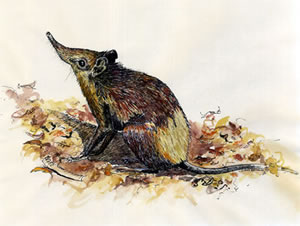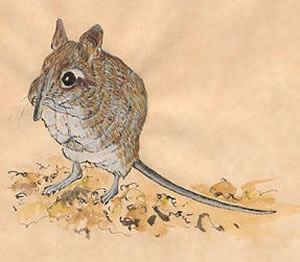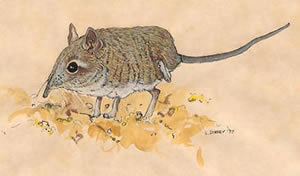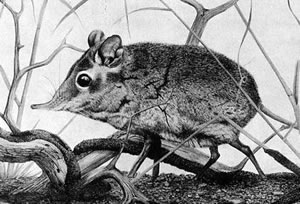Biological Synopsis
By Galen B. Rathbun, Department of Ornithology & Mammalogy, California Academy of Sciences
Phylogeny

Rhynchocyon chrysopygus
Few mammals have had a more colorful history of misunderstood ancestry than the elephant-shrews, or sengis. Most species were first described by Western scientists in the mid to late 19th century, when they were considered closely related to true shrews, hedgehogs, and moles in the order Insectivora. Since then, there has been an increasing realization that they are not closely related to any other group of living mammals, resulting in biologists mistakenly associating them with ungulates, primates, and rabbits. The recent use of molecular techniques to study evolutionary relationships, in addition to the more traditional morphological methods, has confirmed that elephant-shrews represent an ancient monophyletic African radiation. Most biologists currently include the elephant-shrews in a new supercohort, the Afrotheria, which encompasses several other distinctive African groups or clades. These include elephants, sea cows, and hyraxes (the Paenungulata); the aardvark and elephant-shrews, and the golden-moles and tenrecs (Hedges 2001; Springer et al. 2004; Seiffert 2007).
Taxonomy

Elephantulus rufescens
The 20 living species of sengis are well-defined, and their taxonomy is considered nearly definitive (Corbet and Hanks 1968; Rovero, Rathbun, et al., 2008; Smit et al. 2008; Dumbacher et al. 2014), although a few additional new species might be described (Rathbun 2009; Andanje et al. 2010). All living species are in a single family with two subfamilies. The giant elephant-shrews include the genus Rhynchocyon with four species, and the soft-furred elephant-shrews include four genera. Petrodromus is monospecific, Macroscelides has three species, and Elephantulus contains 10 species. The genus Petrosaltator has been created for E. rozeti (Dumbacher et al., 2016) Elephant-shrews were much more diverse during the Miocene period (about 23 million years ago), when an additional four families existed (Holroyd 2010). New fossil forms are also being described (Grossman and Holroyd 2009; Tabuce et al., 2012). Some extinct forms had herbivorous-style teeth that were so similar to the dentition found in living hyraxes that they were first described as hyraxes (Patterson 1965, Butler 1995). The common name "sengi" is being used in place of elephant-shrew by many biologists to try and disassociate the Macroscelidea from the true shrews (family Soricidae) in the order Eulipotyphla (Insectivora).
Sengis are restricted to Africa, and are distributed throughout the continent with the exception of western Africa and the vast Sahara region (Corbet and Hanks 1968; Rathbun 2009). Southern and eastern Africa are centers of diversity. Macroscelides is only found in southwestern Africa, and the greatest number of Elephantulus species occur in southern Africa, followed by eastern Africa. Rhynchocyon only occurs in central and eastern Africa. Petrodromus is among the most widespread. Petrosaltatorrozeti is found only along the northwestern edge of the continent, separated from all other sengis by the Sahara.
Morphology
Rhynchocyon includes the largest and most colorful sengis (see Photographic Gallery). Adults weigh 350-700 g, with head/body and tail lengths up to 310 mm and 250 mm, respectively. The soft-furred species have similar body proportions, but range from about 25 g for Macroscelides to about 200 g for Petrodromus. Species of Elephantulus are 50-60 g. The smaller species are shades of brown and gray (Corbet and Hanks 1968). Most sengi species are born precocial in small litters, although Rhynchocyon young are more altricial (Rathbun 1979, Neal 1995). The long limb bones are adapted for cursorial locomotion (Evans 1942). Some features of sengi tails provide insights into their biology. The relatively long digestive tract includes a caecum (Spinks and Perrin, 1995). Several features of the reproductive tract are distinctive, including the estrus cycle, polyovulation (Horst 1946, Tripp 1971), abdominal testes, and the structure of the penis (Woodall 1995).
Physiology

Elephantulus rufescens
Sengi metabolic rates are typical of most mammals of similar size. However, several species are able to alter their physiology to meet environmental extremes (Perrin 1995a). For example, some species exhibit torpor when they encounter low temperatures (Lovegrove et al. 2001). Their digestive physiology is similar to that of other insectivorous small mammals (Woodall and Currie 1989), despite their likely herbivorous ancestry.
Ecology
Rhynchoycon and Petrodromus are largely confined to lowland and montane forests and dense woodlands, while Elephantulus and Macroscelides are found in more arid lowlands, such as savannahs, scrublands, rocky outcrops, and deserts (Rathbun 2009). In nearly all cases, sengis are found in low densities compared to many other small mammals (FitzGibbon 1995, Perrin 1995b). At low latitudes reproduction is continuous, but at higher latitudes it is seasonal (Neal 1995). All sengis prey on invertebrates, although most soft-furred species supplement this diet with small fruits, seeds, and green plant matter (Rathbun 1979, Kerley 1995). Snakes, raptors, and carnivores are known predators of sengis. A wide variety of parasites are hosted by macroscelids (Fourie et al. 1995).
Behavior
Field studies of representatives of four genera have been completed (Sauer 1973, Rathbun 1979, FitzGibbon 1995; Schubert et al. 2009; Oxenham and Perrin 2009). Monogamous pairs defend congruent territories sex-specifically (males vs. males and females vs. females), although this view may not be true for all species, given recent field studies (Rathbun and Dumbacher, 2014). The giant sengis are strictly diurnal, while the soft-furred species are often crepuscular, with some activity during both day and night. Sengis have well-developed senses of sight, hearing, and smell. Most scent mark their territories with perianal, sternal, subcaudal, or foot glands. Although vocalizations are not common, many species frequently foot drum or tail slap the substrate in stressful situations. Rhynchocyon builds leaf nests on the forest floor, while most soft-furred species use burrows of other species, or construct their own. Some species maintain complicated trail systems through leaf-litter, and several have specialized sheltering habits, such as rock crevices in boulder fields, or relatively exposed spots on runs at the base of bushes.
Husbandry

Petrodromus tetradactylus
In the past 20 years, with increasing knowledge of their natural history, several soft-furred sengis have been successfully kept and bred in captivity. These successes have resulted in increased research on captive animals (Perrin 1995b; Olbricht 2008). Although Rhynchocyon is difficult to maintain, it has recently been bred in captivity. Only Petrodromus has not reproduced in captivity (Tripp 1971, Nicoll and Rathbun 1990), even though it is relatively easy to maintain.
Conservation
On the 2016 IUCN Red List of mammals, most of the 20 sengis are considered "Least Concern", but three species of Elephantulus are listed as "Data Deficient" and two species of giant sengis are at risk. The golden-rumped sengi (Rhynchocyon chrysopygus) is "endangered" and the gray-faced sengi (R. udzungwensis) is "vulnerable". Although the checkered sengi (R. cirnei) and black and rufous sengi (R. petersi) have been down-listed to "least concern", which is the result of inflexibility in the listing protocols. The status of all Rhynchocyon are of concern because they occur in restricted or fragmented forest habitats (Nicoll and Rathbun 1990) that are being heavily impacted by logging practices and clearing for agricultural and urban development (Rathbun and Kyalo 2000). Subsistence hunting for food may also be a problem in some areas.
Summary
A more detailed summary of the biology of extant sengis has been recently published (Rathbun 2009), and a review of fossil forms can be found in (Holroyd 2010). A more comprehensive review of sengi natural history can be found in Heritage, S. 2018. Macroscelidea. Pp. 206-234 in Wilson, D.E. and R. A. Mittermeier (eds.). Handbook of the Mammals of the World, Volume 8, Insectivores, Sloths and Colugos. Lynx Edicions, Barcelona, Spain.
Literature Cited
The following citations represent some of the more important and significant contributions to the sengi literature, including reviews of topics. For additional citations search the Bibliography.
Andanje, S., B. R. Agwanda, G. W. Ngaruiya, R. Amin, and G. B. Rathbun. 2010. Sengi (elephant-shrew) observations from northern coastal Kenya. Journal of East African Natural History 99:1-8.
Butler, P. M. 1995. Fossil Macroscelidea. Mammal Review 25:3-14.
Corbet, G. B., and J. Hanks. 1968. A revision of the elephant-shrews, Family Macroscelididae [14.4 MB PDF]. Bulletin of the British Museum (Natural History), Zoology 16:47-111.
Douady, C. J., F. Catzeflis, J. Raman, M. S. Springer, and M. J. Stanhope. 2003. The Sahara as a vicariant agent, and the role of Miocene climatic events, in the diversification of the mammalian order Macroscelidea (elephant shrews). Proceedings of the National Academy of Sciences USA 100:8325-8330.
Dumbacher, J. P., E. J. Carlen, and G. B. Rathbun. 2016. Petrosaltator gen. nov., a new genus replacement for the North African sengi Elephantulus rozeti (Macroscelidea; Macroscelididae). Zootaxa 4136:567-579.
Dumbacher, J. P., G. B. Rathbun, T. O. Osborne, M. Griffin, and S. J. Eiseb. 2014. A new species of round-eared sengi (genus Macroscelides) from Namibia. Journal of Mammalogy 95:443-454.
Evans, F.G. 1942. The osteology and relationships of the elephant-shrews (Macrosclididae). Bulletin of the American Museum of Natural History 80:85-125.
FitzGibbon, C. D. 1995. Comparative ecology of two elephant-shrew species in a Kenyan coastal forest. Mammal Review 25:19-30.
Fourie, L. J., J. S. Du Toit, D. J. Kok, and I. G. Horak. 1995. Arthropod parasites of elephant-shrews, with particular reference to ticks. Mammal Review 25:31-37.
Grossman, A., and P. A. Holroyd. 2009. Miosengi butleri, gen. et sp. nov., (Marcoscelidea) from the Kalodirr Member, Lothidok Formation, early Miocene of Kenya. Journal of Vertebrate Paleontology 29:957-960.
Hedges, S. B. 2001. Afrotheria: Plate tectonics meets genomics. Proceedings of the National Academy of Sciences USA 98:1-2.
Holroyd, P.A. 2010. Macroscelidea. In Sanders, W.J. and Werdelin, L. (eds.), Cenozoic Mammals of Africa. University of California Press, Berkeley, CA, USA.
Horst, C. J. van der. 1946. Some remarks on the biology of reproduction in the female of Elephantulus, the holy animal of set. Transactions of the Royal Society of South Africa 31:181-199.
Kerley, G.I.H. 1995. The round-eared elephant-shrew (Macroscelides proboscideus) as an omnivore. Mammal Review 25:39-44.
Lovegrove, B.G., J. Raman, and M.R. Perrin. 2001. Daily torpor in elephant shrews (Macroscelidae: Elephantulus spp.) in response to food deprivation. Journal of Comparitive Physiology Series B 171:11-21.
Neal, B.R. 1995. The ecology and reproduction of the short-nosed elephant-shrew, Elephantulus brachyrhynchus, in Zimbabwe with a review of the reproductive ecology of the genus Elephantulus. Mammal Review 25:51-60.
Nicoll, M. E., and G. B. Rathbun. 1990. African Insectivora and Elephant-shrews, an Action Plan for their Conservation [20 MB PDF]. International Union for Conservation of Nature and Natural Resources (IUCN), Gland, Switzerland.
Olbricht, G. 2008. Aspects of the reproductive biology of sengis (Macroscelidea) in general and the postnatal development of the short-eared sengi (Macroscelides proboscideus) in particular. Dissertation. University of Duisburg-Essen, Duisburg, Germany.
Oxenham, K. H., and M. Perrin. 2009. The spatial organization of the four-toed elephant-shrew (Petrodromus tetradactylus) in Tembe Elephant Park, KwaZulu-Natal, South Africa. African Zoology 44:171-180.
Perrin, M.R. 1995a. Comparative aspects of the metabolism and thermal biology of elephant-shrews (Macroscelidea). Mammal Review 25:61-78.
Perrin, M. R. (editor). 1995b. The Biology of Elephant-shrews - A Symposium Held During the 6th International Theriological Congress, Sydney, 5 July 1993. Mammal Review, Vol. 25, No. 1 and 2. 100 pp.
Patterson, B. 1965. The fossil elephant-shrews (Family Macroscelididae). Bulletin of the Museum of Comparative Zoology, Harvard 133:295-335.
Rathbun, G. B. 1979. The social structure and ecology of elephant-shrews [21 MB PDF file]. Zeitschrift fur Tierpsychologie Suppl. 20:1-77.
Rathbun, G. B. 2009. Why is there discordant diversity in sengi (Mammalia: Afrotheria: Macroscelidea) taxonomy and ecology? African Journal of Ecology 47:1-13.
Rathbun, G. B., and J. P. Dumbacher. 2015. Home range and use of diurnal shelters by the Etendeka round-eared sengi, a newly discovered Namibian endemic desert mammal. PeerJ 3:e1302:1-22.
Rathbun, G.B. and S. Kyalo. 2000. Golden-rumped elepant-shrew. Pp 125-129, 340-341 in R.P. Reading and B.J. Miller (eds.). Endangered animals -- conflicting issues. Greeenwood Press, Westport, Connecticut. 388 pp.
Rovero, F., G. B. Rathbun, A. Perkin, T. Jones, D. O. Ribble, C. Leonard, R. R. Mwakisoma, and N. Doggart. 2008. A new species of giant sengi or elephant-shrew (genus Rhynchocyon) highlights the exceptional biodiversity of the Udzungwa Mountains of Tanzania. Journal of Zoology 274:126-133
Sauer, E. G. F. 1973. Zum sozialverhalten der kurzohrigen elefantenspitzmaus, Macroscelides proboscideus. Zeitschrift fur Saugetierkunde 38:65-97.
Schubert, M., C. Schradin, H. G. Rodel, N. Pillay, and D. Ribble. 2009. Male mate guarding in a socially monogamous mammal, the round-eared sengi: on costs and trade-offs. Behavioural Ecology and Sociobiology 64:257-264.
Seiffert, E. R. 2007. A new estimate of afrotherian phylogeny based on simultaneous analysis of genomic, morphological, and fossil evidence. BMC Evolutionary Biology 7:224:13 pp.
Smit, H. A., T. J. Robinson, J. Watson, and B. Jansen van Vuuren. 2008. A new species of elephant-shrew (Afrotheria: Macroscelidea: Elephantulus) from South Africa. Journal of Mammalogy 89:1257-1269.
Spinks, A. C., and M. R. Perrin. 1995. The digestive tract of Macroscelides proboscideus and the effects of diet quality on gut dimensions. South African Journal of Zoology 30:33-36.
Springer, M. S., M. J. Stanhope, O. Madsen, and W. W. De Jong. 2004. Molecules consolidate the placental mammal tree. Trends in Ecology and Evolution 19:430-438.
Tabuce, R., J. Jaeger, L. Marivaux, M. Salem, A. A. Bilal, M. Benammi, Y. Chaimanee, P. Coster, B. Marandat, X. Valentin, and M. Brunet. 2012. New stem elephant-shrews (Mammalia, Macroscedlidea) from the Eocene of Dur At-Talah, Libya. Palaeontology 55:945-955.
Tripp, H.R.H. 1971. Reproduction in elephant-shrews (Macroscelididae) with special reference to ovulation and implantation. Journal of Reproduction and Fertility 26:149-159.
Woodall, P. F. 1995. The male reproductive system and the phylogeny of elephant-shrews (Macroscelidea). Mammal Review 25:87-93.
Woodall, P. F., and G. J. Currie. 1989. Food consumption, assimilation and rate of food passage in the Cape Rock Elephant Shrew, Elephantulus edwardii (Macroscelidea, Macroscelidinae). Comparative Biochemistry and Physiology 92A:75-79.